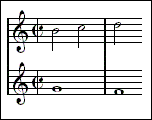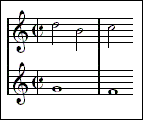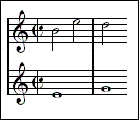Second Species
SECOND species counterpoint involves placing two minims (half notes) against each note of the cantus firmus.
The rules which the notes must satisfy are:
- The first minim must always be consonant with the CF.
- The second minim may be dissonant if it is approached and left by step (figure 1). If it moves by skip it must be consonant.
- Fifths on the first minim of successive bars are not allowed (figure 2) unless the intervening note leaps a fourth, fifth, or minor sixth in the same direction as the CF (figure 2a).
The same constraint applies to octaves on the first minim of successive bars.
- The first note in the penultimate bar must be a perfect fifth above the CF, followed by a major sixth above the CF (figure 3).
As in first species, the counterpoint must begin a 5th or 8ve above the CF, and end an 8ve above the CF.
| figure 1 | figure 2 | figure 2a | figure 3 |
|---|
 |  |  |  |
correct use of
dissonance | bad 5ths | 5ths mitigated
by leap (a 4th). | closing formula |
An example from Gradus

Note the following:
- Since this is in the Aeolian mode, the closing formula has required both minims in the penultimate bar to be sharpened.
- A minim rest has been used in the first bar. (Fux recommends this alternative, but the applet does not currently allow it.)
- Only one unison has been used (on the weak beat of the 6th bar).
- Melodic direction reverses after an ascending leap (an 8ve) in bar 4
- The consecutive 8ves on the downbeat in bars 8 & 9 have been mitigated by the intervening leap of a fourth.
On using the applet
The procedure is the same as for the First Species applet, except that clicking in the first half of a measure places a minim (half note) on the downbeat, and clicking in the second half places a minim on the second beat. Clicking in the final bar places a semibreve (whole note) there.








